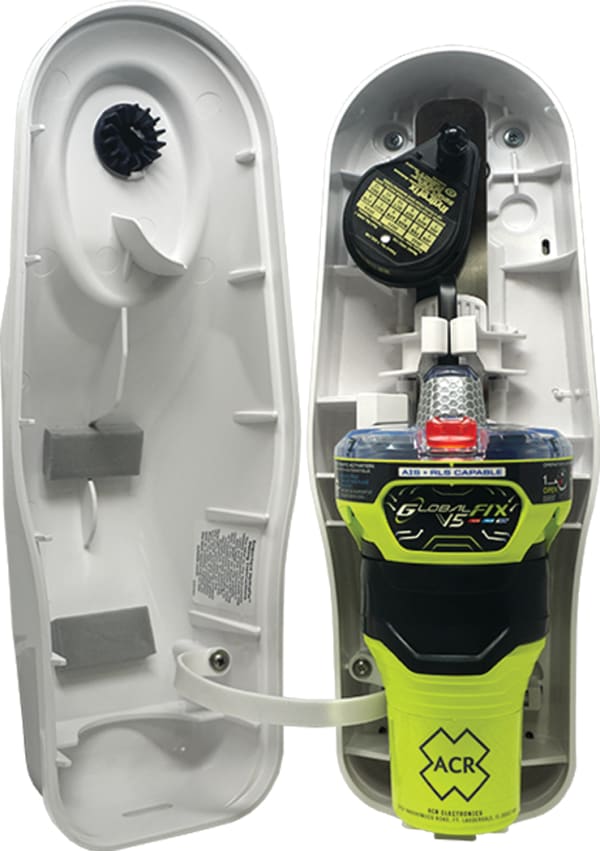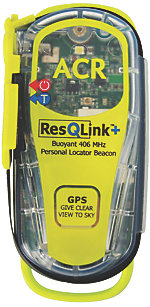Choosing an Emergency Beacon
Understanding the Differences Between EPIRBs, PLBs and SEND Devices
In today's electronic age there is a vast array of electronic tools capable of sending an emergency distress signal – so in this Navigator we explain the main differences between the devices and their best applications.
 EPIRBs
EPIRBs
Emergency Position Indicating Radio Beacons (EPIRBs) are devices that use the 406 MHz distress frequency to transmit an emergency message containing your UIN (Unique Identifying Number) to a worldwide network of satellites that make up the international government-based search and rescue tracking system known as COSPAS-SARSAT. Using the movement between the satellites and your beacon, the system establishes your location and transmits it along with your registration data to the RCC (Rescue Coordination Center). The RCC then coordinates with the closest possible SAR (Search and Rescue) forces to carry out your rescue. Worldwide, this process can take up to 1 hour for non-GPS beacons or as little as 3 minutes for an EPIRB with internal self-locating GPS. That's a pretty big difference when we are talking about an emergency rescue – so if you are planning some serious cruising, make sure your device has integrated GPS like the GlobalFix™ iPro from ACR.
Along with the option for internal GPS, EPIRBs also come in two categories:
- Category I will automatically deploy when a vessel sinks by releasing from its bracket (via a hydrostatic release) when it is submerged 5-13 feet under water. It can still be manually activated while in its bracket (if the boat is not sinking) or it can be taken out of the bracket and manually activated if boarding a life raft.
- Category II beacons are meant to be manually activated either in the bracket (if the boat is not sinking), or after being removed from the bracket (if boarding a life raft). If the device is both removed from its bracket AND comes into contact with water, it will activate automatically.
Most EPIRBs have an operating life that will exceed 48 hours at -20°C (-4°F) once activated. According to ACR, their EPIRB batteries are due to be replaced “six (6) years from date of manufacture or five (5) years after beacon is placed into service, whichever is first, or after emergency use.”
Once purchased, there are no ongoing or monthly expenses for owning or using an EPIRB. That said, it is critical that you register your EPIRB after purchase – a simple process – just follow the easy directions here. The information you provide is what will be relayed to the search and rescue team if your EPIRB is activated, along with the people you would want notified in such an emergency. At a minimum this information should be confirmed and/or updated every two years, but we recommend updating it each season with your new cruising plans.
PLBs
Personal Locator Beacons (PLBs) are very similar to EPIRBs in that they have the same signal strength and use the same 406 MHz distress frequency to transmit data to the COSPAS-SARSAT worldwide rescue system. All new PLBs being sold come with GPS integrated into them – so they have incredibly fast response capability and are meant for use on either land or water. The main difference between EPIRBs and PLBs is their size. PLBs are considerably smaller and meant to be used by an individual – in your pocket or backpack, attached to a life jacket or immersion suit – even in your abandon ship bag. This makes them a great option for people who love to hike, ski or do other adventure sports in remote locations where there may not be good cell phone reception.
PLBs must be manually activated with a clear view to the sky and have a battery life that exceeds 24 hours at -20°C (-4°F), but both PLBs and EPIRBs can run 3-4 times longer above 4.5°C (40°F). Like EPIRBs, ACR recommends that their PLB batteries be replaced “six (6) years from date of manufacture or five (5) years after beacon is placed into service, whichever is first, or after emergency use.”
Another difference between a PLB and an EPIRB is that while an EPIRB is registered to a vessel, a PLB is registered to a specific person – and can be carried wherever you go. As with EPIRBs, it's important to register the device and confirm/update your information at least every two years. If you will be traveling on a yacht – you should add that information to your updates.
If you will be on the water, it's worth noting that while most PLBs like the ResQLink+™ come with built-in floatation – not all of them do, so you may have to buy the extra flotation case. If you do need to activate your PLB from the water – you must make sure to hold it upright with a clear view to the sky – unlike an EPIRB, it will not automatically float that way.
 SEND Devices
SEND Devices
Satellite Emergency Notification Devices are also used to request help in an emergency, but with one major difference – they do NOT use the COSPAS-SARSAT system, but instead use commercial satellite systems with corporation-specific response systems. While that may seem like a downside, SEND devices make up for it by doing a lot more than just transmitting emergency messages. While capabilities vary between devices, most come with the ability to transmit/receive text messages to a select group of people, or even allow you to post to your favorite social network – giving you the ability to share your latest adventure as it is happening. These small, lightweight devices also come with the ability to provide tracking information – so loved ones can always know where you are – if you choose to use it. Of course staying in touch isn't free. SEND devices all require some sort of satellite subscription, usually along with an activation fee.
At Fisheries Supply we offer several versions of the Garmin inReach, which offers emergency assistance, two-way messaging (up to 160 characters), GPS tracking and sharing, location pinging, access to topographic maps, and pairing with mobile devices. inReach uses the Iridium satellite system, so coverage is available worldwide. You will need to activate your device and pay for a service plan – which are available on a monthly or annual basis.
As you can see – there are some pretty significant differences between all these devices and only you can decide which one is the right choice for your application. But when you are ready - Fisheries Supply will have what you need in stock and ready to go.
We hope this Navigator has helped you make an educated choice – but if you still have questions, please feel free to contact our safety experts at (800) 426-6930.
